
Fish friendly farms
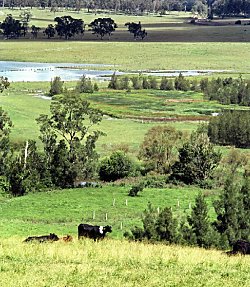
NSW DPI encourages “fish friendly farming”. There are a number of ways that farmers and land managers can improve fish populations in their creeks and wetlands and at the same time improve on-farm productivity.
Fish friendly farms
The health of our rivers and creeks is often influenced by activities on the land, and with more than 90% of all NSW waterways running through farmland, landholders are at the forefront of efforts to restore native fish numbers in our rivers and estuaries.
Often due to poor advice or inadequate communication, many landowners carry out farming activities which can degrade aquatic habitat and lead to a loss of fish from local waterways.
Fish Friendly Farms is a NSW DPI program that encourages farmers to protect fish habitat on and off their properties through sustainable agricultural practices.
The program encourages actions which enhance the health of our rivers and creeks and build native fish populations, including:
- have large woody debris (snags) in streams
- grow native vegetation on the stream bank (riparian area)
- install fish friendly crossings
- control or treat agricultural run-off
- provide water for stock off-stream
- control the opening of floodgates
- protect wetlands.
Fish Friendly Farms publications
7 Key Tips for a Fish Friendly Farm provides technical advice on how to have a Fish Friendly Farm, details of why each aspect is important for native fish, contact details if advice is needed in making farms fish friendly, and also information about what grants are available to undertake on-ground works.
Fishes on Cotton Farms provides information for irrigators and anglers in North West NSW about how they can help native fish and their habitat. This 54 page book has been developed to help landholders protect native fish and includes information on common species of fish in northwest NSW.
What fish is this? is a guide to 56 species of freshwater fish in NSW. The Guide includes detailed colour pictures for each species as well as maps indicating their geographic distribution and is glazed to allow readers to take it down to the water's edge.
A guide to modern fish-protection screening in Australia and the Design specifications for fish protection screens (2021) have been developed to support fish friendly farm infrastructure.
Modern Fish Screens
Modern fish-friendly screens prevent fish and debris from being entering water infrastructure – such as pumps and channels.
Modern screens replace outdated ’trash racks’:
- They have a fine mesh, a large surface area and are self-cleaning (often incorporating brushes, water or air jets).
- They greatly reduce the speed of water entering a water diversion, without changing the volume or rate of water that is diverted.
- They are available in different types to suit any type of pump or gravity-fed diversion, from small to large.
Modern fish screens are good for fish and good for farms. The more modern screens being used in NSW, the more native fish staying in our rivers and less debris entering infrastructure.
NSW DPI has been researching and developing modern screens for over 10 years. The evidence shows that modern screens protect 90% of native fish.
NSW DPI has produced the practical guide to modern fish-protection screening for Australia. This will assist farmers and other water users choose the right screen. The guide accompanies a set of design specifications, which detail how screens need to be engineered.
More information about modern fish screens, their benefits and local suppliers can be found at Boys et al. 2021 and the Fish Screens Australia Website.

These outdated 'trash racks' offer little fish protection and only exclude large debris. (Photos, Craig Boys)

Unscreened or poorly-screened water diversions cost farmers time and money dealing with blocked siphons (left) and inline filters (right). Modern fish screens ease these issues, allowing fish-free and debris-free water to be delivered where it’s needed.
Wetlands on farms
Wetlands on Farms is a program to assist landholders integrate their wetland/s into their farming management. It is currently operating in all catchments west of the Great Dividing Range. Recommendations have been developed to guide the management of wetlands on farms in inland NSW.
Wetlands can be beautiful places. This program is recognises that they can add value in terms of productivity, catchment health and the natural environment through:
- improving the productive and financial value of property
- providing opportunistic grazing and cropping
- slowing flood waters and thus reducing erosion
- helping to remove nutrients and pollutants from water, reducing the risk of algal booms and poor water quality downstream
- providing excellent habitat and breeding grounds for fish, birds and other native plants and animals
- providing recreational opportunities
- having important social and cultural values.
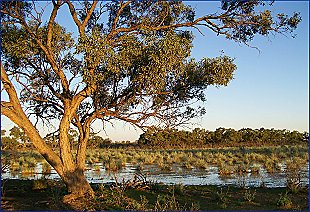
Cattleyard Swamp. Photo: Sam Davis
The Wetlands on Farms team helps landholders develop a wetland management plan for their property by using:
- a comprehensive best management practice guide for wetlands in inland NSW
- a GIS-based wetland planning tool producing information specific to your property.
This will result in:
- high resolution maps of a property using the most up to date information
- a property specific wetland plan including detailed management actions.
On a farm near Narromine, a farmer embarked on a process of rehabilitating his wetlands. These photos were taken in 1994-5.
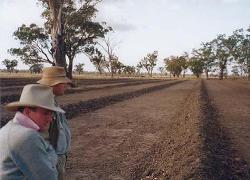
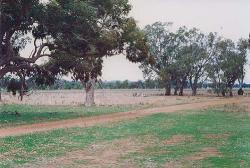
The same scenes in 2007.
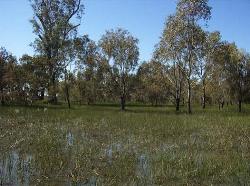
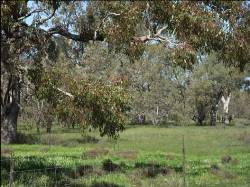
See also ...
- A guide to modern fish protection screening in Australia (PDF, 12.5 MB)
- Best management practices for grazing in wetlands
- Design specifications for fish protection screens in Australia (PDF, 1.4 MB)
- Recommendations for managing wetlands on farms in inland New South Wales
- Wetlands on Farms brochure (PDF, 736.2 KB)

